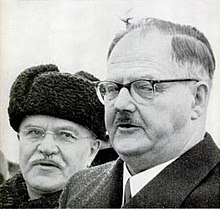Julius Raab
Julius Raab | |
|---|---|
Minister of Commerce and Transport | |
| In office 16 February 1938 – 11 March 1938 | |
| Chancellor | Kurt Schuschnigg |
| Preceded by | Wilhelm Taucher |
| Succeeded by | Hans Fischböck |
| Personal details | |
| Born | 29 November 1891 Vienna University of Technology |
| Profession | Civil engineer |
| Part of a series on |
| Conservatism in Austria |
|---|
 |
Julius Raab (29 November 1891 – 8 January 1964) was a conservative Austrian politician, who served as Federal Chancellor of Austria from 1953 to 1961. Raab steered Allied-occupied Austria to independence, when he negotiated and signed the Austrian State Treaty in 1955. In internal politics Raab stood for a pragmatic "social partnership" and the "Grand coalition" of Austrian Conservatives and Social Democrats.
Biography
Raab was born into a middle-class Catholic family in
The death of his father and the beginning of his political career in the
Raab was ousted after the Anschluss but, unlike many other Austrian political leaders, escaped death or imprisonment through the help of the Lower Austrian Nazi Gauleiter Hugo Jury, whom he knew personally. He was never involved in the Austrian resistance but kept in touch with the old Christian Democrat elite[3] and supported his fellow Leopold Figl after his release from imprisonment.
In April 1945, Raab was made a member of

Raab succeeded Leopold Figl as ÖVP party chairman in 1951 and as Federal Chancellor in 1953. Despite clearly Western attitudes, Raab established excellent relations with post-
In 1957 Raab suffered a light stroke. By the end of the 1950s, his own career and his party's influence declined. In 1961 he passed ÖVP leadership to Alfons Gorbach, who also succeeded him as Federal Chancellor on 11 April. On 28 April 1963 Raab competed in the presidential elections but lost to incumbent Adolf Schärf. His health rapidly deteriorated, and he died, aged 72, in Vienna on 8 January 1964.[6]
Notes
References
- Shell, Kurt Leo (1962). The transformation of Austrian socialism. SUNY Press. ISBN 0-87395-005-4.
- Wilsford, David (1995). Political leaders of contemporary Western Europe: a biographical dictionary. Greenwood Publishing Group. ISBN 0-313-28623-X.
- Wollinetz, Steven (1988). Parties and party systems in liberal democracies. ISBN 0-415-01276-7.
Further reading
- Brusatti, Alois (1986). Julius Raab: eine Biographie in Einzeldarstellungen. R. Trauner. ISBN 3-85320-366-3.
- Raab, Julius (1964). Selbstportraet einer Politikers. Europa Verlag.
External links
- Archive entries with and about Julius Raab in the online archive of the Österreichische Mediathek
- Literature by and about Julius Raab in the German National Library catalogue
- Julius Raab in Austria-Forum (in German) (at AEIOU)
- Entry about Julius Raab in the database Gedächtnis des Landes on the history of the state of Lower Austria (Lower Austria Museum)
- www.datum.at/ Klemens Kaps: „Baumeister des Faschismus“, critical article in the paper, Datum. (2005/09)
- www.jrs.at Julius-Raab-Stiftung for Research and Education

